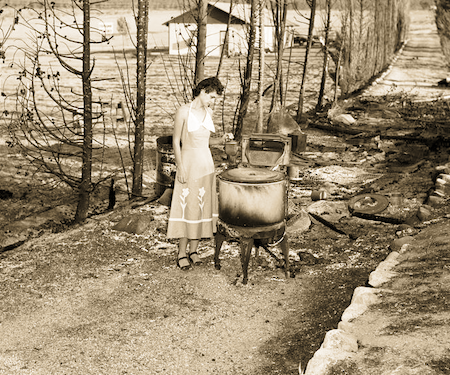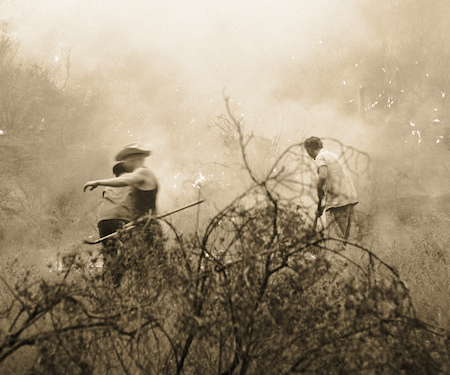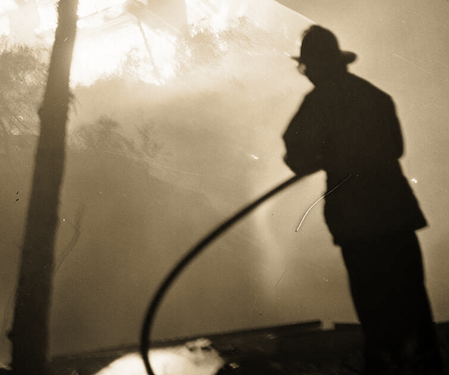Introduction
As colonists expanded west and began to establish permanent settlements in Southern California, fire’s role in the region changed drastically. No longer were small, frequent, wildfires embraced as a norm of the landscape, and instead, this fire regime was lost to a largely successful policy of total fire suppression.[4] After the Big Burn of 1910, in which about 3 million acres of forest burned in Montana and Idaho, leaving 86 people dead, fear regarding fires ballooned amongst the American public. The United States Forest Service capitalized on this momentum and campaigned for more resources to suppress fires. These efforts led to policies such as California’s 1924 law that made intentionally set forest fires, also called prescribed burnings, illegal, and culminated in the Forest Service’s 1935 10 am policy, which determined that all wildfires should be put out by 10 am the morning after they start.[5]
Unfortunately, a mix of fire suppression policy, climate change, and the expanding settlement of humans into the wilderness, also known as the wildland-urban interface, has led to disastrous fires in Southern California. Decades of fire suppression allowed for the buildup of biofuel, and warming temperatures paired with decreased precipitation created optimal conditions for fire. Additionally, more and more people live in regions like Malibu, where fire has always been a staple of the ecosystem. The photo from the1958 Malibu Fire shows an example of the increased destruction that resulted from Southern California’s changing fire regime and the expansion of humans into the wildland urban interface.[6] This problem continues to worsen, and in 2020, wildfires burned a record 4.3 million acres of land in California, which doubled the record set just two years prior.[7]
Southern California has also struggled with urban fire. Westlake, a neighborhood in downtown Los Angeles, was estimated to have the highest number of urban fire occurrences in the country in the early 1990s. This included one fire station accumulating around 20,000 emergency calls in 1993, and the St. George Hotel having three separate fires between the years of 1912 and 1984 that resulted in deaths. The photograph of the 1951 Ralph’s Market Fire in Beverly Hills demonstrates the chaos and destruction typical to Southern California’s urban fire occurrences.[8] Tragedies like this one also inspired the creation of Fire Prevention Week in Los Angeles County and other initiatives aimed at increasing public awareness of fire danger.[9] Many people criticize the fact that millions of dollars are thrown at dealing with seemingly inevitable wildfires in upscale neighborhoods like Malibu and Beverly Hills, while preventable fires, which are often caused by negligent landlords and disregarded building codes, are commonplace in low income areas like Westlake.[10] Hundreds of years ago, humans and fires coexisted and at times even worked together in Southern California. Now however, the two seem to be caught in an escalating clash for control over the region.
[1] Fire, Native Peoples, and the Natural Landscape, edited by Thomas Vale, Island Press, 2002. ProQuest Ebook Central, http://ebookcentral.proquest.com/lib/socal/detail.action?docID=3317362.
[2] Carle, David. Introduction to fire in California. Berkeley, University of California Press, 2008.
[3] ANDERSON, M. KAT. “Methods of Caring for the Land.” Tending the Wild: Native American Knowledge and the Management of California’s Natural Resources, 1st ed., University of California Press, 2005, pp. 125–54. JSTOR, http://www.jstor.org/stable/10.1525/j.ctt1ppfn4.11. Accessed 11 Nov. 2022.
[4] Keeley, Jon E., and C. J. Fotheringham. “Historic Fire Regime in Southern California Shrublands.” Conservation Biology, vol. 15, no. 6, 2001, pp. 1536–48. JSTOR, http://www.jstor.org/stable/3061253. Accessed 11 Nov. 2022.
[5] Romero, Ezra David. “Fire Suppression - and Climate Change - Is to Blame for California's Megafires. Experts Unpack the Term.” CapRadio, 12 Sept. 2020, https://www.capradio.org/articles/2020/09/12/fire-suppression-and-climate-change-is-to-blame-for-californias-mega fires-experts-unpack-the-term/.
[6] Malibu Fire 1958 https://scalar.usc.edu/works/california-burning/index
[7] Woody, Todd. “Fire Suppression Fueled California's Destructive 2020 Blazes, Study Says.” Los Angeles Times, Los Angeles Times, 6 May 2022, https://www.latimes.com/environment/story/2022-05-06/fire-suppression-fueled-california-2020-blazes.
[8] Fire (Ralph’s Market at 3rd and LaCienega) Beverly Hill, 1951 https://scalar.usc.edu/works/california-burning/fire-ralphs-market-at-3rd-and-lacienega-beverly-hills-1951
[9] Fire Prevention Week (Demonstration of Los Angeles County Fire Department, Laurel Grade School, 925 North Hayworth Avenue), 1951
https://scalar.usc.edu/works/california-burning/fire-prevention-week-demonstration-of-los-angeles-county-fire-department-la urel-grade-school-925-
[10] Davis, Mike. “The Case for Letting Malibu Burn.” Environmental History Review, vol. 19, no. 2, 1995, pp. 1–36. JSTOR, https://doi.org/10.2307/3984830. Accessed 12 Nov. 2022.
[2] Carle, David. Introduction to fire in California. Berkeley, University of California Press, 2008.
[3] ANDERSON, M. KAT. “Methods of Caring for the Land.” Tending the Wild: Native American Knowledge and the Management of California’s Natural Resources, 1st ed., University of California Press, 2005, pp. 125–54. JSTOR, http://www.jstor.org/stable/10.1525/j.ctt1ppfn4.11. Accessed 11 Nov. 2022.
[4] Keeley, Jon E., and C. J. Fotheringham. “Historic Fire Regime in Southern California Shrublands.” Conservation Biology, vol. 15, no. 6, 2001, pp. 1536–48. JSTOR, http://www.jstor.org/stable/3061253. Accessed 11 Nov. 2022.
[5] Romero, Ezra David. “Fire Suppression - and Climate Change - Is to Blame for California's Megafires. Experts Unpack the Term.” CapRadio, 12 Sept. 2020, https://www.capradio.org/articles/2020/09/12/fire-suppression-and-climate-change-is-to-blame-for-californias-mega fires-experts-unpack-the-term/.
[6] Malibu Fire 1958 https://scalar.usc.edu/works/california-burning/index
[7] Woody, Todd. “Fire Suppression Fueled California's Destructive 2020 Blazes, Study Says.” Los Angeles Times, Los Angeles Times, 6 May 2022, https://www.latimes.com/environment/story/2022-05-06/fire-suppression-fueled-california-2020-blazes.
[8] Fire (Ralph’s Market at 3rd and LaCienega) Beverly Hill, 1951 https://scalar.usc.edu/works/california-burning/fire-ralphs-market-at-3rd-and-lacienega-beverly-hills-1951
[9] Fire Prevention Week (Demonstration of Los Angeles County Fire Department, Laurel Grade School, 925 North Hayworth Avenue), 1951
https://scalar.usc.edu/works/california-burning/fire-prevention-week-demonstration-of-los-angeles-county-fire-department-la urel-grade-school-925-
[10] Davis, Mike. “The Case for Letting Malibu Burn.” Environmental History Review, vol. 19, no. 2, 1995, pp. 1–36. JSTOR, https://doi.org/10.2307/3984830. Accessed 12 Nov. 2022.
This page has paths:
-
California Burning:
Photographs from the Los Angeles Examiner Curtis Fletcher


